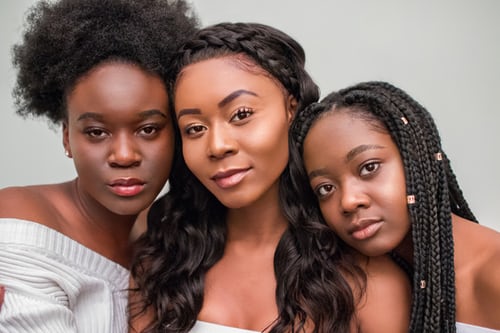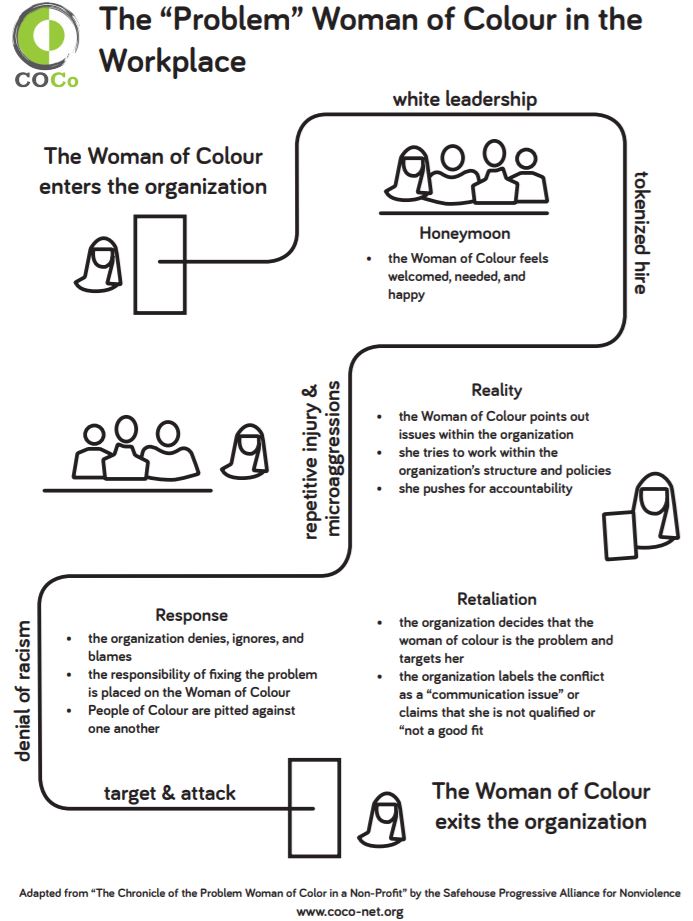Chronicles Repeated as Black Women Blogs Today

A few years ago, I attended a workshop titled “Problem Woman of Colour.” It was expertly facilitated by the respected and gifted Darlene Flynn. The workshop encouraged me to write about chronicles which correlates to what we call Black Women Blogs today.

I was introduced to this graphic which serves as a blueprint of experiences faced by many woman, that look like me, in the workplace.
I shared the graphic with my many Sistah Circles and our consensus is that, the higher the position is in an organization coupled with the lack of leadership diversity, the more likely this blueprint plays out.
Despite being a multicultural society with overwhelming data access, we have not created a meaningful adaptive strategy that supports acclimation of the Black or Brown Woman into a homogeneous organization.
Does it Fit?
I often find myself struggling to find an experience in my own professional career, of almost 30 years, that did not fit into some area of this blueprint. I was genuinely saddened to discover, that the roles that didn’t share this experience were those of an individual contributor. Yet, those roles, had their own type of exclusion, tokenism, glass ceiling, pay inequity, microaggressions, and every concept people before us explained by historically marginalized people.
It would take me 20 more years of being a black woman in the workplace to learn that individual efforts, mine or others, have such a small role in success when compared to the role of systemic, institutional and structural racism systems.
Despite the signing of the legislation intended to create equal opportunity.

It’s fair to say that we all start out in life believing if we get the right education, work hard, meet the right decision-makers, that someone will give us an opportunity to move from Good to Great. Especially, when we see people that look like us ascend to higher level roles. We buy into the dream of possibility.
However, it is short-lived dream by the experiences that our melanin brothers and sisters report they have to endure. Especially in organizations, where there are only one or two leaders of melanin.
Working with no real authority to make decisions, but all of the support in the world to serve as a poster child for diversity initiatives and brochures.
Blog: How Long for the Black Woman?
But still, how can we not be further along to inclusion with all the perks. I started thinking about Jane Elliot’s work in 1968, Blue eyes-Brown eyes.
This was groundbreaking stuff and from a While Woman putting a call to action to treat people well. It was ingenious, but not integrated fulling in our world. As a collective society, we would have to wait for late 1990’s to begin to take action and acknowledge publicly these beliefs are no longer welcomed in the workplace. workplace. And to correlate that these beliefs are the foundation to informal policy and practices such as the glass ceilings, pay disparity, microaggressions, etc.
Even during the days that I was delivering diversity training, I still didn’t have the elementary understanding of structural, systemic or institutional racism. After all, 25 plus years ago diversity training was about celebrating differences, not addressing or confronting the ways Privilege and the Power to act on it decides who gets hired, fired, promoted or access to education, approved for home loans, and meaningful healthcare access where the physician, hears your concern of arm pain and orders an EKG versus an anxiety or anti-depressant pill because your skin is a different color. All of this to say, there is more work to do.

If you want to create a higher performing workplace you must diversify every level in the organization, especially the leadership level. If this will be the first time adding a melanated leader, prepare for the ride and reward. It’s not rocket science. The bottom line is:
- Build trust and demonstrate support
- Be willing to consider your organization may have issues.
Here’s some additional things to consider. Feel free to share additional thoughts.
- Be clear about the level of commitment and support to her success. When the going gets tough, step back and be open to the possibility that other people may be operating from their intentional, implicit or unconscious bias in how they are reporting concerns .
- Trust in her expertise; hopefully this is why you hired her.
- Confront and work through your own issues with Race (and really anything), it could cloud your ability to be objective as issues come up;
- Be open to the experience she may share with you regarding microaggressions or history other melanated employees may bring to her attention. Enlist the support of other leaders to create an environment of belonging.
- Foster open communication; listen to understand not to prove her wrong.
- Show confidence in her by providing coaching as issues arise and creating space for learning.
- Provide public and private support; we come with many experiences of being subjected to all sorts of dynamics – believe us!
Feel free to add other recommendations that support people in being effective and successful in leadership roles. Hope this is helpful.
I continue to use this graphic to represent the Black Woman Chronicles and serve as both a planning and learning opportunity for organizations (and their leaders) to examine the espoused commitment to diversity, equity, inclusion & belonging in the workplace.
However, it’s a challenge to get Good People with Hidden Biases to consider they are operating from this framework. And even harder to relay: when you don’t own your own stuff, good or bad, we all unintentionally reinforce racism (structural, institutional) and noninclusive low performing workplaces.